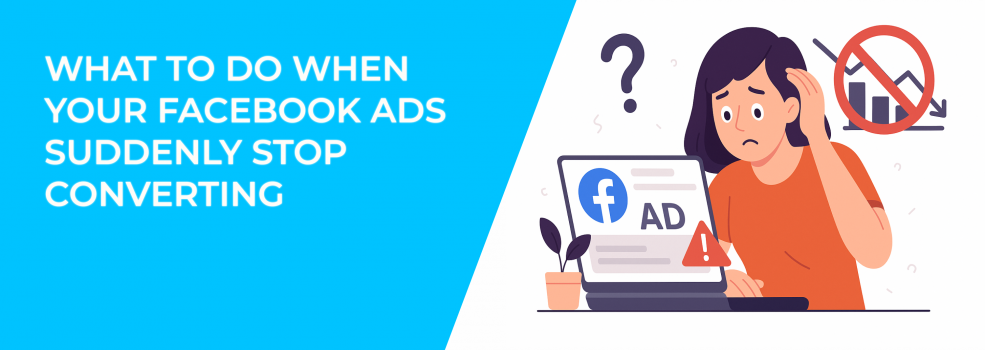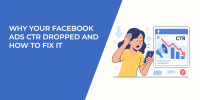Your Facebook ad campaigns were working like a charm. Leads were flowing, sales were steady, and return on ad spend looked great.
Then, suddenly, everything stopped.
No conversions. Rising CPMs. Low engagement.
If you’re wondering why your Facebook ads stopped converting out of nowhere, you’re not alone. It happens to almost every advertiser at some point. The good news? Most issues can be fixed once you know where to look.
In this guide, we’ll walk you through why your Facebook ads might suddenly stop working — and exactly what to do to fix them.
1. Double-Check for Technical Issues
Before diving into complex strategy changes, rule out the simple stuff first. Even a small technical issue can kill conversions fast.
Look out for:
-
Broken landing pages (404 errors, slow load times, or bad mobile UX);
-
Pixel issues (Is your Meta Pixel still firing correctly?);
-
Disabled ad sets or rejected ads;
-
Conflicting campaign settings (wrong optimization event or attribution window).
Action tip: use Facebook’s Event Manager to test if your Pixel is tracking key events like “Lead,” “Purchase,” or “Add to Cart.” If nothing’s firing — that’s your issue.
If your ad sets suddenly show a warning like “Ad Set May Get Zero”, it could also be tied to campaign structure or delivery issues.
2. Refresh Your Creatives and Messaging
Ad fatigue happens faster than you think. Even top-performing creatives can hit a wall after a few weeks.
Signs of ad fatigue:
-
CTRs are dropping,
-
Frequency is rising (above 2.5+),
-
Conversion rate suddenly declines.
What to try:
-
Swap out images, videos, or copy — even a headline change can revive results;
-
A/B test new hooks, benefits, or CTAs;
-
Try different formats (carousel, Reels, or Stories instead of static).
Pro tip: use Meta’s “Breakdown” view by “Age” or “Placement” to see where fatigue is setting in fastest, then focus your refresh there first.
Not sure if you’re dealing with creative burnout? This guide breaks down how to spot ad fatigue early and fix it fast.
3. Revisit Your Targeting Strategy
Your audience may not be responding the same way it used to. Or worse — you may be targeting an outdated or shrinking group.
Common targeting issues:
-
Lookalike audiences based on old customer lists,
-
Interest targeting that no longer exists or works (thanks to Meta's ongoing removals),
-
Narrow targeting that’s throttling delivery.
Smart fixes:
-
Upload a fresh customer list to build new lookalike audiences,
-
Test Advantage+ audience expansion to give Meta more freedom to optimize,
-
Broaden your targeting and layer in exclusions (e.g., recent buyers).
Remember: Facebook’s algorithm performs better with broad, data-rich audiences. The more signals it gets, the smarter it delivers.
If you’re relying on interest categories, make sure you’re updated on the latest changes — these Facebook targeting updates explain what’s still effective.
4. Adjust Your Optimization Goals
Are you asking Facebook to do something it doesn’t have enough data to do?
For example, if you’re optimizing for “Purchases” but only getting one or two per week, your campaign is stuck in learning mode.
Fix it by:
-
Switching your optimization to a higher-funnel event, like “Add to Cart” or “View Content”,
-
Combining low-performing ad sets to allow faster learning,
-
Gradually increasing your budget to feed the algorithm more data.
Goal: help Facebook's system learn faster — with enough conversions per week (at least 50) to stay out of “Learning Limited.”
5. Re-Evaluate Your Offer
The best ads in the world won’t work if your offer falls flat.
Ask yourself:
-
Is the value of your offer immediately clear?
-
Is there urgency or a compelling reason to act now?
-
Does it solve a real pain point for your audience?
Try refreshing your offer with:
-
A new bundle, limited-time discount, or added bonus,
-
Messaging that focuses on benefits, not just features,
-
A more tailored CTA depending on where users are in the funnel.
Example: instead of saying, “Download our free guide,” say “Get our 3-step formula to double your online sales — free.” Specificity sells.
6. Watch for Platform or External Changes
Sometimes, it’s not you — it’s Meta.
Facebook frequently updates its ad platform. These changes can affect everything from ad delivery to attribution. On top of that, seasonality and outside events (like holidays or economic shifts) can mess with performance.
Here’s what to monitor:
-
Rising CPMs — often a sign of increased competition,
-
Changes in placement performance (e.g., Reels vs. Feed),
-
Drops in engagement across all campaigns.
Helpful tip: use Facebook’s Ad Library and industry tools to keep an eye on what your competitors are running. If everyone’s switching to Reels or Advantage+ shopping — maybe you should, too.
7. Take a Strategic Pause (Not a Panic Pause)
If you’ve tested your creative, checked your targeting, reviewed your pixel, and adjusted optimization — it might be time to pause and regroup.
But don’t shut everything down at once.
Do this instead:
-
Pause only the lowest-performing ad sets,
-
Duplicate winning ad sets with fresh creative,
-
Launch a small test campaign with a different offer or funnel step.
Bonus tip: sometimes a micro-budget test with $10–20/day can reveal more than scaling a broken campaign. Keep your experiments lean and focused.
Final Thoughts
When your Facebook ads stop converting, it feels urgent. But rushing to overhaul everything can make things worse. Instead, take a methodical approach.
- Check for tech issues,
- Refresh your creative,
- Update targeting and optimization,
- Rethink your offer,
- Analyze external trends.
Small adjustments, done smartly, often outperform a total reset.
And remember: Facebook advertising isn’t just about reacting. It’s about testing, learning, and adapting with every campaign.

